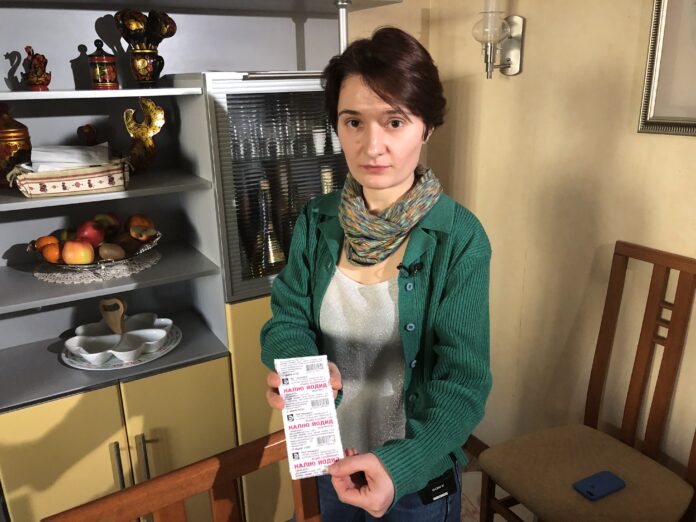The towers and transformers of the South Ukraine Nuclear Power Plant loom on the grassy shore of a reservoir where a fisherman cast his line into the choppy waters.
Located in the city of Yuzhnoukrainsk, the facility is the largest of its kind not held by the Russian forces, whose recklessness around such sites has raised global concerns.
The risks of living next to nuclear reactors during a war that is being fought with missiles, shells and rockets go without saying.
But the Yuzhnoukrainsk plant has become an unlikely source of security to some Ukrainians, who reason that Russia wouldn’t dare attack the city.
“It’s a nuclear plant. Come on, you couldn’t. It’s so dangerous and stupid to fight here,” said Nataly Proskurenko, who recently fled Kyiv for Yuzhnoukrainsk.
Read more:
Married in a Ukrainian bomb shelter
Another resident echoed that view. After the war started, he also left Kyiv for the nuclear town, which he said the Russian forces could not bombard the way they had elsewhere.
“Because it’s dangerous, even for them,” said Olek, who did not want his surname published for security reasons.
Moscow’s tactic of besieging cities and pounding them from a distance would not only endanger Ukraine and Europe if tried in Yuzhnoukrainsk, he added. Russian itself would be at risk.
The irresponsibility of the Russian forces around nuclear facilities has been one of the most alarming parts of President Vladimir Putin’s Feb. 24 invasion of Ukraine.
The International Atomic Energy Agency’s director-general Rafael Mariano Grossi has said he was “gravely concerned” about the safety of Ukraine’s nuclear sites.
Despite the risks of living in the shadow of nuclear reactors in wartime, Nataly Proskurenko, left, and Nick Feofentov, fled Kyiv for Yuzhnoukrainsk.
Stewart Bell/Global News
Russian troops attacked the Chornobyl nuclear plant at the outset of their war, trapping workers who manage the site of the 1986 disaster.
A shell reportedly hit a building at the Zaporizhzhia nuclear power plant, the largest in Europe, on March 4, igniting a fire and damaging a transformer.
Russia now controls the facility.
Ukrainian officials have also complained in recent days that Russian forces were firing at Kharkiv’s National Science Centre, which houses a research reactor.
The IAEA said Monday the Kharkiv facility had been hit by shelling and the agency had been notified of “additional damage when it came under renewed fire a few days ago, but its small amount of nuclear material remained intact.”
Just over two weeks ago, Russian troops came within about 30 km of Yuzhnoukrainsk, locals said, but they were repelled by the Ukrainian defence forces.
Trending Stories
Will Smith slap: Actor hitting Chris Rock at Oscars prompts LAPD statement, flood of memes
Oscars 2022: Best and worst-dressed celebrities on the red carpet
A city of apartment blocks on the Southern Bug River, Yuzhnoukrainsk was built to house workers at the nearby nuclear and hydroelectric plants.
Nick Feofentov grew up in the city, but moved to Kyiv, where he earned his PhD and worked as a game designer.
When Russian invasion forces crossed the border into Ukraine and headed for Kyiv, he and Proskurenko, his wife, decided it was no longer safe to stay.
“It sounded like this place is much safer than Kyiv,” Feofentov said of Yuzhnoukrainsk.
In Kyiv, they could see bombs exploding from their window. They suspected Putin’s plan was to capture and occupy the capital.
“So that’s why we were really afraid that probably our apartment soon would be destroyed,” said Proskurenko, who was running a peace-building project when the war started.
War monument in Yuzhnoukrainsk, home to Ukraine’s second-largest nuclear power plant.
Stewart Bell/Global News
They thought about going to west Ukraine, where many of their friends had settled, but it was crowded, and really there was nowhere safe anymore.
“It’s like Russian roulette,” Proskurenko said.
They made the 360-kilometre journey south to live with Feofentov’s parents. His mother is a pediatric doctor and his father is an engineer at the nuclear plant. His brother also works at the plant.
Feofentov was convinced the Russian forces “won’t be so crazy to take over the power plant,” he said in an interview at his family’s third-floor apartment.
Their confidence was tested when the Russians captured the Enerhodar nuclear plant, near Zaporizhzhya in the southeastern part of the country.
But Feofentov said that having been raised in a town where nuclear safety was taught at school, he was not afraid in Yuzhnoukrainsk.
“Me personally, I believe in our armed forces, and I believe they are holding Mykolaiv region very well and they won’t let Russians get to this point,” he said.
Yuzhnoukrainsk was built to house workers at the nearby South Ukraine Nuclear Power Plant.
Stewart Bell/Global News
After arriving in the city, Global News was contacted by local security forces, restricted from filming at most locations and accompanied by an escort.
There has been fighting to the south of the city in Mykolaiv.
Since moving in with Feofentov’s parents just over two weeks ago, the couple has been working at a volunteer centre that distributes food, medicine and hygiene kits to villages in the region.
“Until the end, we hope that, even if Russian troops will try to come to the city, they will not fight too much, and we will just protest and organize, probably, some meetings against Russian aggression,” Proskurenko said.
Still, they are ready should the worst happen.
They cleaned out the basement and stocked it with chairs, blankets and water. And they keep potassium iodide, which temporarily blocks the effects of nuclear poisoning, on a kitchen shelf, in a basket above the fruit bowl.
“We bought some tablets, pills that you can take if the nuclear plant will explode,” Proskurenko said. “It will not help too much but at least you will last several days.”
Russia-Ukraine conflict: How each country is attempting to win the information war
© 2022 Global News, a division of Corus Entertainment Inc.



